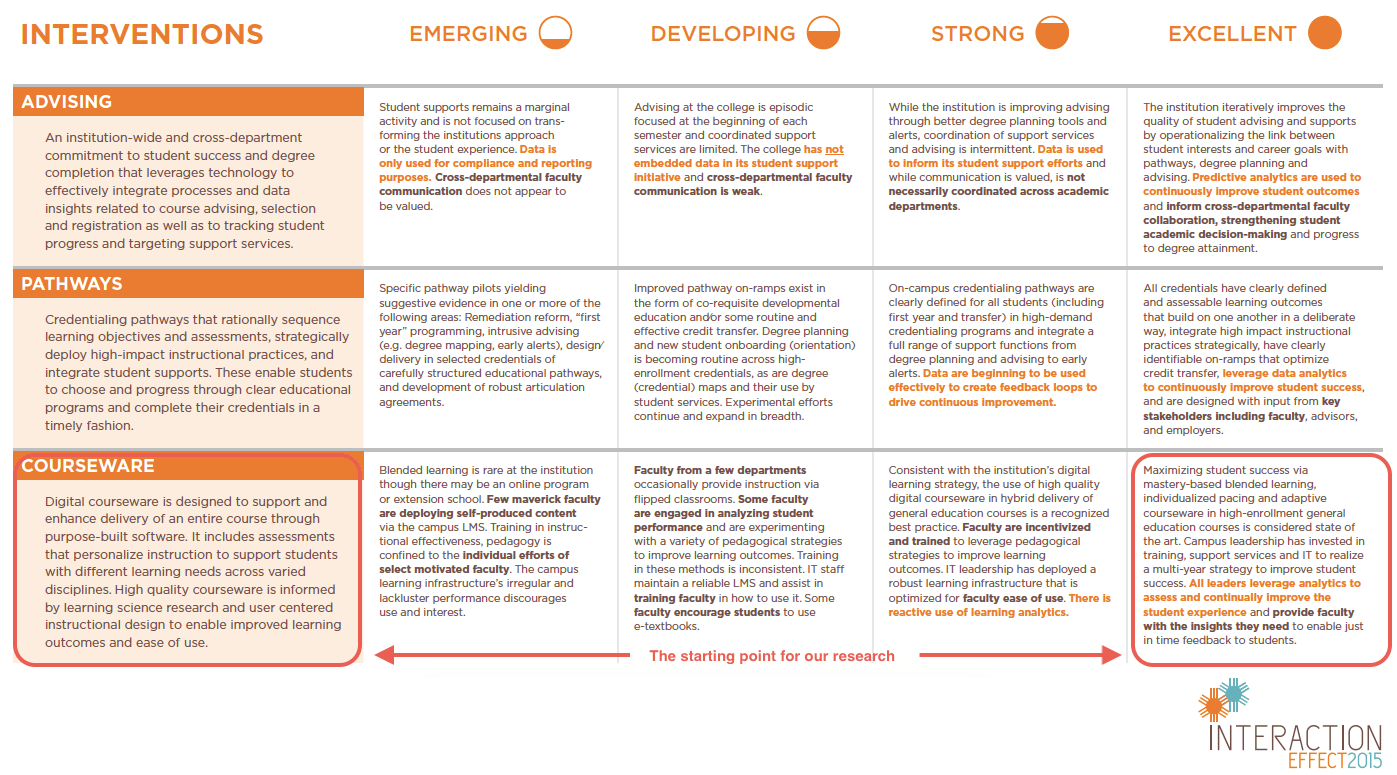Thinking about learning innovation is often an exercise in unanswerable questions.
First and foremost, what’s the best way to plan for and measure innovation? How can institutions replicate successful strategies? How are global educators getting insight into what’s working in learning innovation programs? Equally important, how are they getting insight into what doesn’t work? How are administrators providing support and what do instructors need in order to continuously improve their teaching? Which technologies and pedagogies do instructors prefer?
As an edtech company with a lot of determination to help educators continue moving forward, we resolved that it was within our power to find and share some answers.
Digital learning innovation
While universities and colleges are innovating across many areas, our research focused on gaining insight into efforts around digital learning innovation, which we defined thus:
“Digital learning innovation is tech-enabled, though not necessarily online. It includes both browser-based learning experiences and offline technology in the classroom.”
Now, after hearing from hundreds of educators, we’re pleased to release the Digital Learning Innovation 2017 Report to share what we’ve learned. We also included some of our own insights and musings from our decade of experience working with higher education at a global scale.
What’s inside?
- The five dimensions of digital learning innovation and how universities prioritize and strategize around them (read more below).
- How to measure and improve the quality of digital learning experiences.
- What instructors need from institutions to support their work in learning innovation.
- Which strategies and efforts are worth scaling — and which aren’t.
- Methods for effectively allocating budget to sponsor innovation.
- What we predict is coming in the future of digital learning innovation.
Background
To begin this work, we reached out to collaborate with university, learning, and research specialists in Australia and the U.S.
Many thanks to our research committee and advisors at: Australian Council for Educational Research (ACER), Bill & Melinda Gates Foundation, Center for Education Through Exploration (ETX) at Arizona State University, Deakin Centre for Research in Assessment and Digital Learning (CRADLE), and the Melbourne Centre for the Study of Higher Education (CSHE).
Regional focus
The Digital Learning Innovation 2017 Report focuses on the state of higher education in Australia.
Why? It’s logically impossible to create a report that paints an accurate picture of global higher education; every country is operating under different circumstances, with different laws, allowances, and restrictions.
Our experience working with Australian institutions shows that these universities are innovating in digital learning and successfully improving student outcomes along the way. We believe their work can be replicated to improve education domestically and abroad if we make an effort to share knowledge.
Research method
With the help of our research committee and advisors, we created an online anonymous survey. We disseminated it to our database of contacts, contacts through our committee, attendees at the Learning Innovation Summit 2017, and several public channels. When reviewing responses, we excluded those who responded they are not employed by an Australian university.
Through this survey and additional phone interviews, we gathered the voices of university-employed educators. Instructors, instructional designers, administrators, and other university leaders self-reported on the state of the digital learning innovation programs at their institutions. At the time of publishing, the online survey was completed by nearly 200 educators in Australia.
We have perhaps collected a partisan understanding of learning innovation, but nonetheless we believe the survey is helpful in answering questions about useful approaches to creating and scaling learning innovation programs.
This is only part one. We will continue publishing new information as we dig deeper and interview more educators. Our long-term plan is to replicate this report annually and continue digging into the success of digital learning innovation in higher education around the globe.
Research goals
We seek to push higher education forward. With this report and those we create in the future, our aim is to share what leading international institutions are doing well, and to help institutions conduct more in-depth evaluation of where they stand in comparison.
Underlying research goals:
- Understand ongoing trends in teaching & learning.
- Measure the current degree of learning innovation penetration.
- Identify common challenges faced in instructor-led and university-led efforts.
- Pinpoint successful strategies for innovating learning.
We believe our findings will aid universities in their work to adopt innovative, effective teaching and learning practices, and accelerate the spread of best practices in digital learning. Our hope is that this report will be used as a resource for creating successful learning innovation strategies and programs.
Report Highlight:
The 5 dimensions of courseware innovation
The five dimensions of learning innovation were the foundation of our research and report. The survey we created consisted of questions that are mapped to each dimension, so we ensured that we gathered complete information on what institutions are doing to succeed.
We defined these dimensions using ongoing work from the Bill & Melinda Gates Foundation. Their team conducted research, surveys, and community reviews to discern and analyze what it takes to successfully transform higher education. They asked diverse set of over seventy institutions and systems one question: “What’s helping and what’s limiting your work to transform your institution to improve outcomes for low-income, first-generation students?”
With that information, they created a self-assessment rubric for institutions to understand how they’re doing across three dimensions and six capacities. Seen here in an early version:
They have since slightly altered their overall rubric, but the information we worked with remains relevant and important to an understanding of learning innovation.
Analyzing their definition of courseware (see row three in the image above) and description of what it takes to achieve excellence, we distilled five key dimensions of successful innovation:
Modality
Quality
Assessment & Analytics
Support
Strategy
For institutions to produce excellent courseware (or digital learning innovations), it is important to address all five of these dimensions in their program.
How we hope this report helps you
We interviewed and surveyed instructors, instructional designers, deans, provosts, and other university administrators and leadership to help educators in similar roles improve their work in digital learning innovation.
Instructors: Learn what other instructors are doing, in what ways, to inform your own teaching practices, pedagogy, and use of technology. Thereby, advance your teaching practices and provide increasingly effective learning experiences for students.
Instructional Designers: Learn what other instructional designers are doing, in what ways, to inform your design methodologies and use of technology. Thereby, provide innovative learning experiences for students and improve collaboration with instructors and colleagues.
Deans: Learn what is needed to better support instructors, e.g. more training, more instructional designers, more financial support, etc. Thereby, improve courseware, student outcomes, and retention through the improvement of your instructors.
Administrators & Leadership: Learn what strategy and support you can help provide, e.g. better L&T unit structure, innovation centers, budget strategies, goal setting, creating a culture that embraces innovation, etc. Thereby, improve the overall success of your institution and learning innovation programs.
Anyone interested in higher education: Understand the current state of digital learning innovation programs, including the strategy, efficacy, implemented technology, favored pedagogy, and more.
Download the Digital Learning Innovation 2017 Report
We hope you learn from what fellow educators have shared about digital learning innovation at their institutions. Download the free report here.

If you have feedback, insights, questions, or you’d like to hear more, please contact us at communications@smartsparrow.com or use our contact form.



